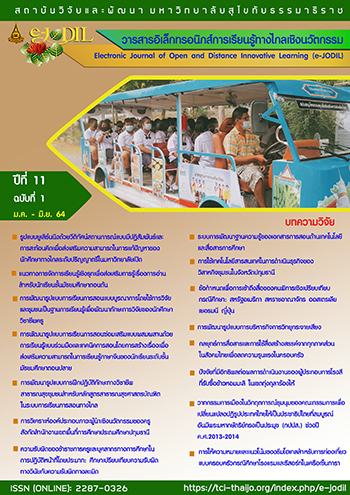การให้ความหมายและแนวโน้มของธีมโฮเทลสำหรับการท่องเที่ยวแบบครอบครัว กรณีศึกษาโรงแรมและรีสอร์ทในเครือเซ็นทารา
Main Article Content
บทคัดย่อ
การวิจัยนี้มีวัตถุประสงค์เพื่อ 1) ศึกษาการให้ความหมายของธีมโฮเทล 2) ศึกษาแนวโน้มของธีมโฮเทลสำหรับการท่องเที่ยวแบบครอบครัว การดำเนินการวิจัยครั้งนี้เป็นการวิจัยเชิงคุณภาพ (Qualitative Research) แบบวิธีปรากฏการณ์วิทยา (Phenomenology) โดยใช้การสัมภาษณ์เชิงลึก (In-depth Interview) แบบกึ่งโครงสร้าง (Semi-Structured Interview) กับผู้ให้ข้อมูลหลัก (Key Informant) ได้แก่ ผู้มีหน้าที่รับผิดชอบเกี่ยวกับการบริหารโรงแรมและรีสอร์ทในเครือเซ็นทารา จำนวน 10 คน จากการคัดเลือกกลุ่มตัวอย่างแบบเจาะจง (Purposive Sampling) และผ่านการวิเคราะห์ข้อมูลโดยใช้วิธีการวิเคราะห์เชิงเนื้อหา (Content Analysis)
ผลการศึกษาพบว่า ธีมโฮเทล (Themed Hotel) เป็นโรงแรมที่มีการออกแบบสถาปัตยกรรมให้มีเอกลักษณ์ มีลักษณะเฉพาะ มีความโดดเด่น แตกต่างจากโรงแรมทั่วไป ใช้การสื่อสารผ่านการเล่าเรื่อง วัฒนธรรม การจินตนาการ ความเป็นตัวตน เพื่อให้ลูกค้าได้สัมผัสถึงความเสมือนจริง รับรู้ และรู้สึกเหมือนได้ไปอยู่ในเรื่องราวนั้นจริงๆ มีการตกแต่งเชิงสัญลักษณ์ในทุกๆ องค์ประกอบให้เป็นไปในทิศทางเดียวกันทั้งหมด ทั้งโครงสร้างภายนอก การตกแต่งภายใน วัสดุอุปกรณ์ต่างๆ การบริการ รวมไปถึงพนักงาน เป็นการสร้างบรรยากาศให้สภาพแวดล้อมในโรงแรมสอดคล้องกับธีม เพื่อสร้างประสบการณ์ให้กับลูกค้า กลายเป็นความทรงจำที่ดี และอยากกลับมาอีก จนกลายเป็นจุดหมายปลายทางสำหรับวันหยุดของครอบครัว นอกจากนี้ แนวโน้มของธีมโฮเทลสำหรับการท่องเที่ยวแบบครอบครัวยังคงเติบโตได้ดีและมีโอกาสในการขยายตัวอีกมากตามแนวโน้มของตลาดการท่องเที่ยวแบบครอบครัว โดยแนวโน้มของธีมโฮเทลสำหรับการท่องเที่ยวแบบครอบครัวในอนาคตต้องคำนึงถึง 5 ปัจจัยสำคัญ ดังนี้ 1) การออกแบบธีมที่แปลกใหม่ 2) การสร้างประสบการณ์และจุดหมายปลายทางวันหยุด 3) กิจกรรมเสริมสร้างความรู้ 4) เทคโนโลยีที่ทันสมัย 5) อิทธิพลของเด็กและครอบครัวหลากหลายวัย
Downloads
Article Details
บทความ ข้อความ ภาพประกอบ ตารางประกอบ ที่ตีพิมพ์ในวารสารเป็นความคิดเห็นและความรับผิดชอบของผู้เขียนแต่เพียงผู้เดียว ไม่เกี่ยวข้องกับมหาวิทยาลัยสุโขทัยธรรมาธิราชแต่อย่างใด
บทความที่เสนอพิจารณาในวารสาร e-JODIL ต้องเป็นบทความที่ไม่เคยส่งไปลงพิมพ์ เผยแพร่ หรืออยู่ระหว่างการพิจารณาของวารสารอื่น
กองบรรณาธิการขอสงวนสิทธิ์ในการพิจารณาและตัดสินการตีพิมพ์บทความในวารสาร
เอกสารอ้างอิง
กระทรวงการท่องเที่ยวและกีฬา. (2560). ยุทธศาสตร์ กระทรวงการท่องเที่ยวและกีฬา ฉบับที่ ๔ (พ.ศ. ๒๕๖๐ – ๒๕๖๔). สืบค้นเมื่อ 2 เมษายน 2563, จาก https://www.mots.go.th/download/article/article_20171201174031. pdf.
กระทรวงการท่องเที่ยวและกีฬา. (2563). สถานการณ์ด้านการท่องเที่ยวเดือนมกราคม-ธันวาคม 2562. สืบค้นเมื่อ 2 เมษายน 2563, จาก https://www.mots.go.th/download/article/article_20200123132650.jpg.
กองวิจัยการตลาด ททท. (2558). การศึกษาแนวโน้มและทิศทางการท่องเที่ยวไทยในปี 2563 Thai Tourism Scenario 2020. สืบค้นเมื่อ 2 เมษายน 2563, จาก http://www.etatjournal.com/web/menu-read-tat/menu-2015/menu-22015/654-22015-scenario2020.
กองเศรษฐกิจการท่องเที่ยวและกีฬา. (2563). สถิติด้านการท่องเที่ยว ปี 2562 (Tourism Statistics 2019). สืบค้นเมื่อ 2 เมษายน 2563, จาก http://econ-mots.com/.
ขจรศักดิ์ บัวระพันธ์. (2560). การวิจัยเชิงคุณภาพไม่ยากอย่างที่คิด. นครปฐม: สถาบันนวัตกรรมการเรียนรู้ มหาวิทยาลัยมหิดล.
Agoda. (2018). ชาวเอเชียนิยมท่องเที่ยวกับครอบครัวเป็นอันดับหนึ่ง; อโกด้าเผยผลสำรวจเทรนด์การท่องเที่ยวเป็นครอบครัว ประจำปี 2018. สืบค้นเมื่อ 1 มีนาคม 2563, จาก https://www.agoda.com/th-th/press/ชาวเอเชียนิยมท่องเที่ย?cid=-999.
Baramizi, L. (2020). HOTEL TRENDS 2020: แนวโน้มการออกแบบประสบการณ์โรงแรมประจำปี 2020. สืบค้นเมื่อ 2 เมษายน 2563, จาก https://www.wazzadu.com/article/4152.
Birchler, K. M. (2012). A Vacation within a Vacation: An Examination of How Child Participation in Day Programs during Family Vacations Influences Parental Satisfaction with the Vacation (Master of Science in Education Theses). Southern Illinois University Carbondale. USA.
Carr, N. (2011). Children’s and Families’ Holiday Experiences. New York: Routledge.
Crompton, J. L. (1981). Dimensions of the Social Group Role in Pleasure Vacations. Annals of Tourism Research, 8(4), 550-568.
Firat, F.A. (2011). Living a theme. Consumption Markets & Culture, 12(2), 193-202.
Fountain, J., Schänzel, H., Stewart, E. & Körner, N. (2015). Family Experiences of Visitor Attractions in New Zealand: Differing Opportunities for ‘Family Time’ and ‘Own Time’. Annals of Leisure Research, 18(3), 342-358.
Gottdiener, M. (2001). The Theming of America: American Dreams, Media Fantasies, and Themed Environments. Boulder: Westview Press.
Grbich, C. (2013). Content Analysis of Texts: Qualitative Data Analysis. London: Sage Publications Ltd.
Gua, P. (2013). Some Issues on Evaluation of the Theme Hotel with the Travelers' Experience Factors. In T. Honghua (Ed.), ICCC '13: Proceedings of the Second International Conference on Innovative Computing and Cloud Computing (pp. 254–257). Wuhan: ACM Wuhan Chapter.
Holjevac, I. A. (2003). A vision of tourism and the hotel industry in the 21st century. International Journal of Hospitality Management, 22(2), 129- 134.
Katchwattana, P. (2019). ผลวิจัยการันตี ‘เทรนด์ท่องเที่ยวกลุ่มรายได้ดี’ มาแรง แนะเทคนิค SME คว้าโอกาสให้ทัน. สืบค้นเมื่อ 2 เมษายน 2563, จาก https://www.salika.co/2019/08/17/premium-wellness-travel-trend-2562/.
Kendall, A. (2012). Family Vacations in the 21st Century: An Exploratory Study of Nonresident Fathers (Master of Science Thesis). University of Florida. USA.
Khoo-Lattimore, C., Prayag, G., & Cheah, B. L. (2015). Kids on Board: Exploring the Choice Process and Vacation Needs of Asian Parents with Young Children in Resort Hotels. Journal of Hospitality Marketing & Management, 24(5), 511-531.
Lehto, X.Y., Choi, S., Lin, Y. & MacDermid, S. M. (2009). Vacation and Family Functioning. Annals of Tourism Research, 36(3), 459-479.
Li, M., Wang, D., Xu, W., & Mao, Z. (2017). Motivation for Family Vacations with Young Children: Anecdotes from the Internet. Journal of Travel & Tourism Marketing, 34(8), 1047-1057.
Lew, A. A., Hall, C. M. & Williams, A. M. (2004). A Companion to Tourism. Oxford: Blackwell Publishing Ltd.
Lewis, J. (2006). Children, Changing Families and Welfare States. Cheltenham: Edward Elgar.
Ma, J. (2015). The Countermeasure Study of Theme Hotel in the View of Silk Road Economic Belt - Case study of Development of Theme Hotel in the Region of Xinjiang. In H. Zhou (Ed.), Proceedings of the 2015 International Conference on Education, Management and Computing Technology (pp.858-862). Tianjin: Atlantis Press.
Obrador, P. (2012). The place of the family in tourism research: domesticity and thick sociality by the pool. Annals of Tourism Research, 39(1), 401-420.
Prinz, F. (2009). More Theme Hotels. Salenstein: Braun Publishing.
Rugh, S. (2008). Are We There Yet? The Golden Age of American Family Vacations. Lawrence: University Press of Kansas.
Schänzel H. A. & Yeoman I. (2014). The Future of Family Tourism. Tourism Recreation Research, 39(3), 343–360.
Schänzel H. A. & Yeoman I. (2015). Trends in family tourism. Journal of Tourism Futures, 1(2), 141-147.
Shaw, S., Havitz, M. & Delemere, F. (2008). I Decided to Invest in My Kids’ Memories: Family Vacations, Memories, and the Social Construction of the Family. Tourism, Culture & Communication, 8(1), 13–26.
Srnec, T., Lončarić D. & Perišić Prodan, M. (2016). Family Vacation Decision Making Process: Evidence from Croatia. In Proceedings of 23rd Biennial International Congress Tourism & Hospitality Industry 2016 (pp.432-445). Croatia. University of Rijeka.
Sylt, C. (2016). I Cover the Theme Park Industry and the Business of Formula One How Theme Parks Help to Break New Ground in The Hotel Industry. Retrieved March 28, 2020, from https://www.forbes.com/sites/csylt/2016/09/19/how-theme-parks-help-to-break-new-ground-in-the-hotel-industry/#2a8dda666310
Wisegeek. (2020). What Is a Themed Hotel?. Retrieved March 27, 2020, from https://www.wisegeek.com/what-is-a-themed-hotel.htm.
Wood, N. T. & Muñoz, C. L. (2007). No Rules, Just Right’ or is it? The Role of Themed Restaurants as Cultural Ambassadors. Tourism and Hospitality Research, 7(3–4), 242–255.
World Economic Forum. (2019). The Travel & Tourism Competitiveness Report 2019. Retrieved April 2, 2020, from http://www3.weforum.org/docs/WEF_TTCR_2019.pdf.
Xiao, Q., Zhang, H. Q. & Huang, H. (2013). The Effects of Hotel Theme Strategy: An Examination on the Perceptions of Hotel Guests on Theme Elements. Journal of China Tourism Research, 9(1), 133 – 150.
Zerhusen II, R. F. (2007). Entertainment Architecture: Contextually Integrated Water Park Resort in Norwood, Ohio (Master of Architecture Theses). B. S. Architecture, University of Cincinnati. USA.


